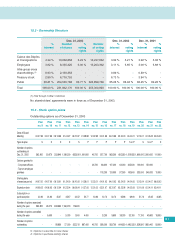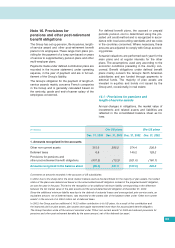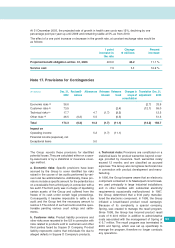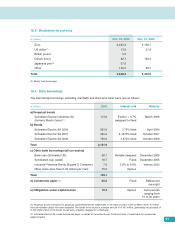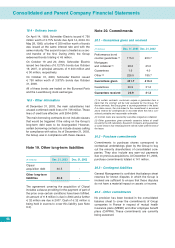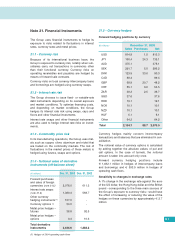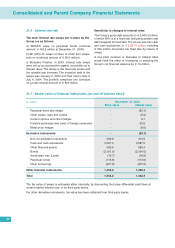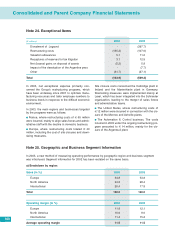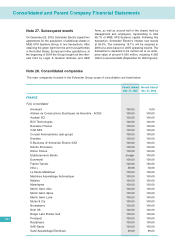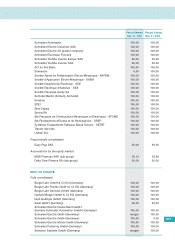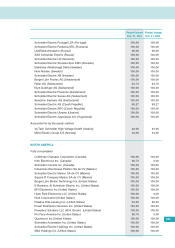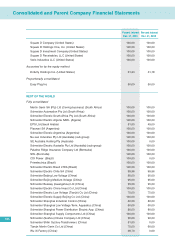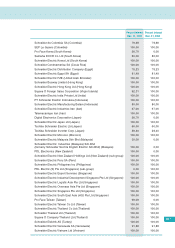APC 2003 Annual Report Download - page 99
Download and view the complete annual report
Please find page 99 of the 2003 APC annual report below. You can navigate through the pages in the report by either clicking on the pages listed below, or by using the keyword search tool below to find specific information within the annual report.
Note 21. Financial Instruments
The Group uses financial instruments to hedge its
exposure to risks related to fluctuations in interest
rates, currency rates and metal prices.
21.1 - Currency risk
Because of its international business base, the
Group is exposed to currency risk, notably when sub-
sidiaries carry out transactions in currencies other
than their functional currency. Currency risks on
operating receivables and payables are hedged by
means of forward sale contracts.
Currency risks on local currency intercompany loans
and borrowings are hedged using currency swaps.
21.2 - Interest rate risk
The Group chooses to issue fixed- or variable-rate
debt instruments depending on its overall exposure
and market conditions. To optimize financing costs,
and depending on market conditions, the Group
hedges its interest rate risk using swaps, caps and
floors and other financial instruments.
Interest rate swaps and other financial instruments
are also used to hedge interest rate risks on invest-
ments.
21.3 - Commodity price risk
In its manufacturing operations, the Group uses met-
als such as copper, silver, aluminum and nickel that
are traded on the commodity markets. The risk of
fluctuations in the market prices of these metals is
hedged using futures, swaps and options.
97
21.4 - Notional value of derivative
instruments (off-balance sheet)
(
€
millions)
Dec. 31, 2003 Dec. 31, 2002
Forward purchases
and sales of foreign
currencies
(note 21.5)
2,076.0 611.3
Interest rate swaps
(note 21.6)
1,360.4 568.7
Other currency
hedging instruments (1) 107.0 -
Currency options (1) 54.0 -
Metal price hedges –
futures 38.8 92.5
Metal price hedges –
options 0.4 10.3
Total derivative
instruments 3,636.6 1,282.8
(1) Hedges of 2004 operating cash flows
21.5 - Currency hedges
Forward hedging positions by currency
(
€
millions)
December 31, 2003
Sales Purchases Net
USD 814.8 1.5 813.3
JPY 160.4 24.3 136.1
AUD 375.1 375.1
SEK 291.7 5.5 286.2
DKK 123.9 33.6 90.3
CAD 89.4 89.4
GBP 68.9 20.7 48.2
CHF 55.1 0.6 54.5
ZAR 39.2 2.5 36.7
SGD 37.6 37.6
HKD 19.1 19.1
NOK 10.1 10.1
NZD 10.1 10.1
HUF 5.1 5.1
Other 64.2 64.2
Total 2,164.7 88.7 2,076.0
Currency hedges mainly concern intercompany
transactions and balances that are eliminated in con-
solidation.
The notional value of currency options is calculated
by adding together the absolute values of put and
call options. In the case of tunnels, the notional
amount is taken into account only once.
Forward currency hedging positions include
€1,482.1 million in hedges of intercompany loans
and borrowings and €593.9 million in hedges of
operating cash flows.
Sensitivity to changes in exchange rates
A 1% change in the exchange rate against the euro
of the US dollar, the Hong Kong dollar and the British
pound –corresponding to the three main sources of
the Group’s exposure to currency risks– would have
the effect of increasing or reducing the value of the
hedges on these currencies by approximately €2.7
million


